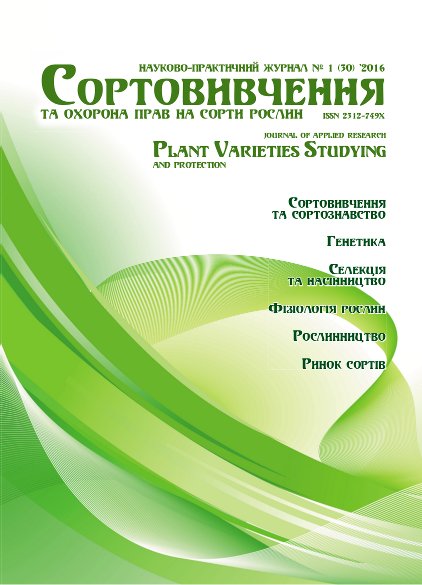Breeding value of the second generation of soybean populations for «growing season» trait
DOI:
https://doi.org/10.21498/2518-1017.1(30).2016.61788Keywords:
soybean, crossbreeding combinations, hybrid combinations, phenotype, parents, early ripenessAbstract
Purpose. Studying the inheritance of such trait of soybean (Glucine max (L.) Merrill) as growing season length in F2 and assessing hybrid combinations to identify more quick-ripening phenotypes as compared to parents. Methods. Laboratory test, mathematico-statistical evaluation. Results. In most crossbreeding combinations, when parents differed by growing season length, late ripeness was dominated in F2, in one combination – early ripeness, in two combinations, when parents scarcely differed by growing season length, complementary effect was observed for this index. It was found that ‘Anzhelika’/‘Mageva’ combination generated the highest number of more quick-ripening forms than any of the parents (13.1%), a smaller number was identified in ‘Legenda’/‘Vizhion’ (6.4%) and ‘Anzhelika’/‘Gentleman’ (4.0%), and barely noticeable number was observed in ‘Legenda’/‘Yelena’ combination (1.3%). Conclusions. In the following crossbreeding combinations as ‘Legenda’/‘Vizhion’, Legenda’/‘Korado’, ‘Legenda’/‘Ustia’, ‘Legenda’/‘Yelena’, ‘Yug-30’/‘Gentleman’, ‘No. 894’/‘Vizhion’, ‘Anzhelika’/‘Annushka’, ‘No. 894’/‘Annushka’, ‘Legenda’/‘Annushka’, ‘No. 441’/‘Gentleman’, ‘No. 441’/‘Vizhion’, ‘No. 441’/‘Annushka’, ‘Anzhelika’/‘Gentleman’ and ‘Anzhelika’/‘Prypiat’ when parents considerably and insignificantly differ by growing season length, late ripeness was dominated in F2. ‘Ustia’/‘Vizhion’ and ‘Yug-30’/‘ Vizhion’ crossbreeding combinations in which parents hardly differ by growing season, complementary effect was observed in F2 for this index.
Downloads
References
Leshchenko, A. K. (1965). Kultura soi na Ukraini [Soybean culture in Ukraine]. Kyiv: Vyd-vo Ukr. akadem. s.-h. nauk [in Ukrainian].
Mikhaylov, V. G. (1986). Nasledovanie prodolzhitel’nosti perioda vegetatsii u soi [Inheritance of vegetation period duration in soybean]. In Biologiya, selektsiya i genetika soi [Biology, breeding and genetics of soybean] (pp. 110–125). Novosibirsk: N.p. [in Russian].
Mykhailov, V. H. (2005). Kharakterystyka hibrydiv soi F2 za tryvalistiu periodu vehetatsii, masoiu nasinnia ta vysotoiu roslyn [Characteristics of F2 soybean hybrids for vegetation period duration, seed weight and plant height]. Selektsia i nasinnitstvo [Selection and Seed Industry], 90, 175–187 [in Ukrainian].
Mykhailov, V. H., Starychenko, V. M., Shcherbyna, O. Z., & Romaniuk, L. S. (2004). Uspadkuvannia tryvalosti periodu vehetatsii ta inshykh kilkisnykh oznak hibrydamy F1 soi [Inheritance of duration of vegetation period and other quantitative characters by F1 soybean hybrids]. Visnik ukrains’kogo tovaristva genetikiv i selekcioneriv [The Bulletin of Vavilov Society of Geneticists and Breeders of Ukraine], 2(1), 53–65 [in Ukrainian].
Mykhailov, V. H., Shcherbyna, O. Z, Romaniuk, L. S., & Starychenko, V. M. (2003). Kharakterystyka hibrydiv soi F1 [Characteristics of F1 soybean hybrids]. Zbirnyk naukovykh prats Instytutu zemlerobstva [Collected of Scientific papers of the Institute of Agriculture], Special issue, 99–104 [in Ukrainian].
Sichkar, V. I., & Lugovoy, A. P. (1986). Kharakter korrelyatsionnykh svyazey mezhdu elementami produktivnosti u soi [The nature of correlation relationships between soybean productivity elements]. In Biologiya, selektsiya i genetika soi [Biology, breeding and genetics of soybean] (pp. 92–100). Novosibirsk: N.p. [in Russian].
Babych, A. O., & Kokhaniuk, N. V. (2014). Uspadkuvannia tryvalosti periodu vehetatsii u mizhvydovykh hibrydiv soi [Inheritance of vegetation period duration by soybean interspecies hybrids]. Peredhirne ta hirske zemlerobstvo i tvarynnytstvo [Foothill and mountain agriculture and stockbreeding], 56(II), 3–8 [in Russian].
Korsakov, N. I. & Bulakh, P. P. (1978). Izmenchivost’ i nasledstvennaya obuslovlennost’ priznakov soi [Variability and hereditary determination of soybean characters]. Trudy po prikladnoy botanike, genetike i selektsii [Proceedings on Applied Botany, Genetics and Breeding], 63(1), 81–101.
Downloads
Published
How to Cite
Issue
Section
License
Copyright (c) 2016 Ukrainian Institute for Plant Variety Examination

This work is licensed under a Creative Commons Attribution-ShareAlike 4.0 International License.
Starting in 2022, the copyright to the publication remains with the authors
Our journal abides by the CREATIVE COMMONS copyright rights and permissions for open access journals.
Authors, who are published in this journal, agree to the following conditions:
- The authors reserve the right to authorship of the work and pass the first publication right of this work to the journal under the terms of a Creative Commons Attribution License, which allows others to freely distribute the published research with the obligatory reference to the authors of the original work and the first publication of the work in this journal.
- The authors have the right to conclude separate supplement agreements that relate to non-exclusive work distribution in the form in which it has been published by the journal (for example, to upload the work to the online storage of the journal or publish it as part of a monograph), provided that the reference to the first publication of the work in this journal is included.

























 Ukrainian Institute for Plant Varieties Examination
Ukrainian Institute for Plant Varieties Examination  Селекційно-генетичний інститут
Селекційно-генетичний інститут Institute of Plant Physiology and Genetics of the National Academy of Sciences of Ukraine
Institute of Plant Physiology and Genetics of the National Academy of Sciences of Ukraine
 The National Academy of Agrarian Sciences of Ukraine
The National Academy of Agrarian Sciences of Ukraine